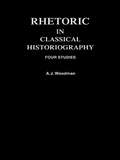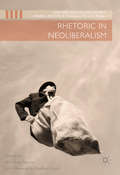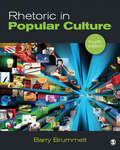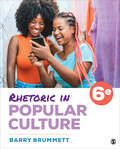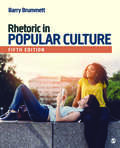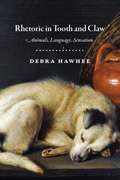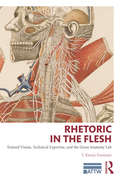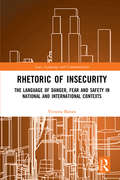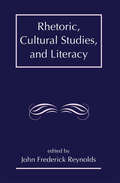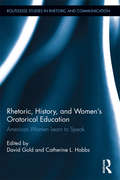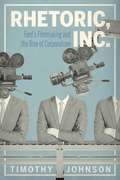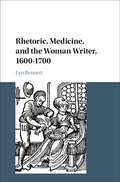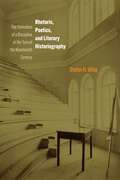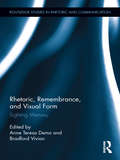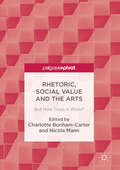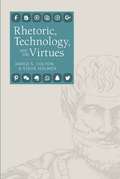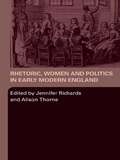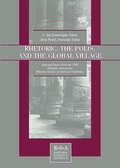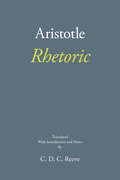- Table View
- List View
Rhetoric in Classical Historiography: Four Studies
by A.J. WoodmanThis radical study argues against the view that the historian's craft has remained largely unchanged since classical times. Includes detailed discussion of the work of Thucydides, Cicero, Sallust, Livy and Tacitus.
Rhetoric in Debt (RSA Series in Transdisciplinary Rhetoric)
by Kellie Sharp-HoskinsIn recent years, household indebtedness in the United States reached its highest levels in history. From mortgages to student loans, from credit card bills to US deficit spending, debt is widespread and increasing.Drawing on scholarship from economics, accounting, and critical rhetoric and social theory, Kellie Sharp-Hoskins critiques debt not as an economic indicator or a tool of finance but as a cultural system. Through case studies of the student-loan crisis, medical debt, and the abuses of municipal bonds, Sharp-Hoskins reveals that debt is a rhetorical construct entangled in broader systems of wealth, rule, and race. Perhaps more than any other social marker or symbol, the concept of “debt” indicates differences between wealthy and poor, productive and lazy, secure and risky, worthy and unworthy. Tracking the emergence and work of debt across temporal and spatial scales reveals how it exacerbates vulnerabilities and inequities under the rhetorical cover of individual, moral, and volitional calculation and equivalency.A new perspective on a serious problem facing our society, Rhetoric in Debt not only reveals how debt organizes our social and cultural relations but also provides a new conceptual framework for a more equitable world.
Rhetoric in Neoliberalism
by Kim Hong NguyenThis volume examines and applies classical and contemporary concepts of rhetorical theory and criticism to the context of late capitalism. Each contributor shows how discourse, its subjects, and power relations are irrevocably transformed by neoliberalism. The collection analyzes a range of discourses and phenomena in neoliberalism including: higher education reforms, computational culture, Occupy Wall Street protests, the activism of Warren Buffett, and the 9-11 Truth Movement. Together, these chapters explore the contemporary rhetorical production of homo economicus and the various ways in which neoliberalism has become a way of thinking, orienting, and organizing all aspects of life around economized metrics of individualized and individuated success. This book will be of use to students and scholars crossing the fields of media and communication, political science, and sociology.
Rhetoric in Popular Culture
by Barry S. BrummettThe Fourth Edition of Barry Brummett’s Rhetoric in Popular Culture provides readers with in-depth insight into the techniques of rhetorical criticism to analyze the full spectrum of contemporary issues in popular culture. From movies, magazines and advertisements, to social networking sites, music videos and television shows, Dr. Brummett presents key rhetorical concepts and applies them with critical analysis to a variety of exciting examples drawn from today's popular culture. Moving from theory to practice throughout the text, Brummett links concepts in an easy-to-understand way. Rhetoric in Popular Culture covers the concept rhetoric, itself, as well as its place and dynamic change in history, and offers methods to effectively employ rhetorical criticism in daily life. The new edition includes pertinent critical essays and case studies that show readers how the critical methods discussed can be used to study the hidden rhetoric of extended texts, and more.
Rhetoric in Popular Culture
by Barry S. BrummettThe Sixth Edition of Barry Brummett’s Rhetoric in Popular Culture provides readers with in-depth insight into the techniques of rhetorical criticism to analyze the full spectrum of contemporary issues in popular culture. Exploring a wide range of mass media texts including advertisements, magazines, movies, television, popular music, and social media, Barry Brummett presents key rhetorical concepts and applies them with critical analysis to a variety of exciting examples drawn from today′s popular culture. Ideal for courses in rhetorical criticism, the new edition includes new and updated sample critical essays and case studies that demonstrate for readers how the critical methods discussed can be used to study the hidden rhetoric of popular culture.
Rhetoric in Popular Culture
by Barry S. BrummettThe Sixth Edition of Barry Brummett’s Rhetoric in Popular Culture provides readers with in-depth insight into the techniques of rhetorical criticism to analyze the full spectrum of contemporary issues in popular culture. Exploring a wide range of mass media texts including advertisements, magazines, movies, television, popular music, and social media, Barry Brummett presents key rhetorical concepts and applies them with critical analysis to a variety of exciting examples drawn from today′s popular culture. Ideal for courses in rhetorical criticism, the new edition includes new and updated sample critical essays and case studies that demonstrate for readers how the critical methods discussed can be used to study the hidden rhetoric of popular culture.
Rhetoric in Popular Culture: Brummett: Rhetoric In Popular Culture 4e + Brummett: Techniques Of Close Reading (Studies In Rhetoric And Communication)
by Barry S. Brummett“An accessible introduction to contemporary rhetorical theory and its applications in everyday life.” —Cory Brewster, Eastern Oregon University Rhetoric in Popular Culture, Fifth Edition, shows you how to apply growing and cutting-edge methods of critical studies to a full spectrum of contemporary issues seen in daily life. Exploring a wide range of mass media including current movies, magazines, advertisements, social networking sites, music videos, and television shows, Barry Brummett uses critical analysis to apply key rhetorical concepts to a variety of exciting examples drawn from popular culture. You are guided from theory to practice in an easy-to-understand manner, providing you with a foundational understanding of the definition and history of rhetoric as well as new approaches to the rhetorical tradition. The highly anticipated Fifth Edition includes new critical essays and case studies that demonstrate for you how the critical methods discussed can be used to study the hidden rhetoric of popular culture.
Rhetoric in Popular Culture: Brummett: Rhetoric In Popular Culture 4e + Brummett: Techniques Of Close Reading (Studies In Rhetoric And Communication)
by Barry S. Brummett“An accessible introduction to contemporary rhetorical theory and its applications in everyday life.” —Cory Brewster, Eastern Oregon University Rhetoric in Popular Culture, Fifth Edition, shows you how to apply growing and cutting-edge methods of critical studies to a full spectrum of contemporary issues seen in daily life. Exploring a wide range of mass media including current movies, magazines, advertisements, social networking sites, music videos, and television shows, Barry Brummett uses critical analysis to apply key rhetorical concepts to a variety of exciting examples drawn from popular culture. You are guided from theory to practice in an easy-to-understand manner, providing you with a foundational understanding of the definition and history of rhetoric as well as new approaches to the rhetorical tradition. The highly anticipated Fifth Edition includes new critical essays and case studies that demonstrate for you how the critical methods discussed can be used to study the hidden rhetoric of popular culture.
Rhetoric in Tooth and Claw: Animals, Language, Sensation
by Debra HawheeWe tend to think of rhetoric as a solely human art. After all, only humans can use language artfully to make a point, the very definition of rhetoric. Yet when you look at ancient and early modern treatises on rhetoric, what you find is surprising: they’re crawling with animals. With Rhetoric in Tooth and Claw, Debra Hawhee explores this unexpected aspect of early thinking about rhetoric, going on from there to examine the enduring presence of nonhuman animals in rhetorical theory and education. In doing so, she not only offers a counter-history of rhetoric but also brings rhetorical studies into dialogue with animal studies, one of the most vibrant areas of interest in humanities today. By removing humanity and human reason from the center of our study of argument, Hawhee frees up space to study and emphasize other crucial components of communication, like energy, bodies, and sensation. Drawing on thinkers from Aristotle to Erasmus, Rhetoric in Tooth and Claw tells a new story of the discipline’s history and development, one animated by the energy, force, liveliness, and diversity of our relationships with our “partners in feeling,” other animals.
Rhetoric in the Flesh: Trained Vision, Technical Expertise, and the Gross Anatomy Lab (ATTW Series in Technical and Professional Communication)
by T. Kenny FountainRhetoric in the Flesh is the first book-length ethnographic study of the gross anatomy lab to explain how rhetorical discourses, multimodal displays, and embodied practices facilitate learning and technical expertise and how they shape participants’ perceptions of the human body. By investigating the role that discourses, displays, and human bodies play in the training and socialization of medical students, T. Kenny Fountain contributes to our theoretical and practical understanding of the social factors that make rhetoric possible and material in technical domains. Thus, the book also explains how these displays, discourses, and practices lead to the trained perspective necessary for expertise. This trained vision is constructed over time through what Fountain terms embodied rhetorical action, an intertwining of body-object-environment that undergirds all scientific, medical, and technical work. This book will be valuable for graduate and advanced undergraduate courses in technical and professional communication (technical communication theory and practice, visual or multimodal communication, medical technical communication) and rhetorical studies, including visual rhetoric, rhetoric of science, medical rhetoric, material rhetoric and embodiment, and ethnographic approaches to rhetoric.
Rhetoric of InSecurity: The Language of Danger, Fear and Safety in National and International Contexts (Law, Language and Communication)
by Victoria BainesThis book demands that we question what we are told about security, using tools we have had for thousands of years. The work considers the history of security rhetoric in a number of distinct but related contexts, including the United States’ security strategy, the "war" on Big Tech, and current concerns such as cybersecurity. Focusing on the language of security discourse, it draws common threads from the ancient world to the present day and the near future. The book grounds recent comparisons of Donald Trump to the Emperor Nero in a linguistic evidence base. It examines the potential impact on society of policy-makers’ emphasis on the novelty of cybercrime, their likening of the internet to the Wild West, and their claims that criminals have "gone dark". It questions governments’ descriptions of technology companies in words normally reserved for terrorists, and asks who might benefit. Interdisciplinary in approach, the book builds on existing literature in the Humanities and Social Sciences, most notably studies on rhetoric in Greco-Roman texts, and on the articulation of security concerns in law, international relations, and public policy contexts. It adds value to this body of research by offering new points of comparison, and a fresh but tried and tested way of looking at problems that are often presented as unprecedented. It will be essential to legal and policy practitioners, students of Law, Politics, Media, and Classics, and all those interested in employing critical thinking.
Rhetoric, Cultural Studies, and Literacy: Selected Papers From the 1994 Conference of the Rhetoric Society of America
by John Frederick ReynoldsThis volume presents a representative cross-section of the more than 200 papers presented at the 1994 conference of the Rhetoric Society of America. The contributors reflect multi- and inter-disciplinary perspectives -- English, speech communication, philosophy, rhetoric, composition studies, comparative literature, and film and media studies. Exploring the historical relationships and changing relationships between rhetoric, cultural studies, and literacy in the United States, this text seeks answers to such questions as what constitutes "literacy" in a post-modern, high-tech, multi-cultural society?
Rhetoric, Fantasy, and the War on Terror (Routledge Studies in Media, Communication, and Politics)
by Vaheed RamazaniThe book draws on psychoanalytic and semiotic perspectives to examine popular, political, legal, and journalistic discourses mediating the War on Terror. The analysis encompasses governmental speeches, legal documents, print and broadcast journalism, and military memoirs under the Bush, Obama, and Trump administrations. Dominant motifs include American exceptionalism and its historical affinity for war, the synergy between the technologies of war and media, the role of the "military-industrial-media-entertainment network" in promoting the American culture of militarism, the dialectic of identification and repulsion in the construction of "the enemy," and the political and mediatic normalization of fear. The author explores in particular the role of desire in the rhetorical construction and naturalization of the fantasy of a global War on Terror. Scholars and students alike will take interest in this original contribution to the fields of cultural studies, psychoanalysis, media studies, rhetoric, critical international relations, and international humanitarian law and ethics.
Rhetoric, History, and Women's Oratorical Education: American Women Learn to Speak (Routledge Studies in Rhetoric and Communication)
by David Gold Catherine L. HobbsHistorians of rhetoric have long worked to recover women's education in reading and writing, but have only recently begun to explore women's speaking practices, from the parlor to the platform to the varied types of institutions where women learned elocutionary and oratorical skills in preparation for professional and public life. This book fills an important gap in the history of rhetoric and suggests new paths for the way histories may be told in the future, tracing the shifting arc of women's oratorical training as it develops from forms of eighteenth-century rhetoric into institutional and extrainstitutional settings at the end of the nineteenth century and diverges into several distinct streams of community-embodied theory and practice in the twentieth. Treating key rhetors, genres, settings, and movements from the early republic to the present, these essays collectively challenge and complicate many previous claims made about the stability and development of gendered public and private spheres, the decline of oratorical culture and the limits of women's oratorical forms such as elocution and parlor rhetorics, and women's responses to rhetorical constraints on their public speaking. Enriching our understanding of women's oratorical education and practice, this cutting-edge work makes an important contribution to scholarship in rhetoric and communication.
Rhetoric, Inc.: Ford’s Filmmaking and the Rise of Corporatism (RSA Series in Transdisciplinary Rhetoric #15)
by Timothy JohnsonIn 1914, the Ford Motor Company opened its Motion Picture Laboratory, an in-house operation that produced motion pictures to educate its workforce and promote its products. Just six years later, Ford films had found their way into schools and newsreels, travelogues, and even feature films in theaters across the country. By 1961, it is estimated that the company’s movies had captured an audience of sixty-four million people.This study of Ford’s corporate film program traces its growth and rise in prominence in corporate America. Drawing on nearly three hundred hours of material produced between 1914 and 1954, Timothy Johnson chronicles the history of Ford’s filmmaking campaign and analyzes selected films, visual and narrative techniques, and genres. He shows how what began as a narrow educational initiative grew into a global marketing strategy that presented a vision not just of Ford or corporate culture but of American life more broadly. In these films, Johnson uncovers a powerful rhetoric that Ford used to influence American labor, corporate style, production practices, road building, suburbanization, and consumer culture. The company’s early and continued success led other corporations to adopt similar programs.Persuasive and thoroughly researched, Rhetoric, Inc. documents the role that imagery and messaging played in the formation of the modern American corporation and provides a glimpse into the cultural turn to the economy as a source of entertainment, value, and meaning.
Rhetoric, Inc.: Ford’s Filmmaking and the Rise of Corporatism (RSA Series in Transdisciplinary Rhetoric #15)
by Timothy JohnsonIn 1914, the Ford Motor Company opened its Motion Picture Laboratory, an in-house operation that produced motion pictures to educate its workforce and promote its products. Just six years later, Ford films had found their way into schools and newsreels, travelogues, and even feature films in theaters across the country. It is estimated that by 1961, the company’s movies had captured an audience of sixty-four million people.This study of Ford’s corporate film program traces its growth and rise in prominence in corporate America. Drawing on nearly three hundred hours of material produced between 1914 and 1954, Timothy Johnson chronicles the history of Ford’s filmmaking campaign and analyzes selected films, visual and narrative techniques, and genres. He shows how what began as a narrow educational initiative grew into a global marketing strategy that presented a vision not just of Ford or corporate culture but of American life more broadly. In these films, Johnson uncovers a powerful rhetoric that Ford used to influence American labor, corporate style, production practices, road building, suburbanization, and consumer culture. The company’s early and continued success led other corporations to adopt similar programs.Persuasive and thoroughly researched, Rhetoric, Inc. documents the role that imagery and messaging played in the formation of the modern American corporation and provides a glimpse into the cultural turn to the economy as a source of entertainment, value, and meaning.
Rhetoric, Medicine, and the Woman Writer, 1600–1700
by Lyn BennettHow did physicians come to dominate the medical profession? Lyn Bennett challenges the seemingly self-evident belief that scientific competence accounts for physicians' dominance. Instead, she argues that the whole enterprise of learned medicine was, in large measure, facilitated by an intensely classical education that included extensive training in rhetoric, and that this rhetorical training is ultimately responsible for the achievement of professional dominance. Bennett examines previously unexplored connections among writers and genres as well as competing livelihoods and classes. Engaging the histories of rhetoric, medicine, literature, and culture throughout, she goes on to focus specifically on the work of women who professed as well as practiced medicine. Pointing to some of the ways women's writing shapes realities of body, mind, and spirit as it negotiates social, cultural, and professional ideologies of gender, this book offers an important corrective to some long-held beliefs about women's role in early modern discourse.
Rhetoric, Poetics, and Literary Historiography: The Formation of a Discipline at the Turn of the Nineteenth Century
by Stefan H. UhligIn Rhetoric, Poetics, and Literary Historiography, Stefan H. Uhlig offers a new account of the emergence of literary studies. Most histories of the early years of the field search for unifying origins of literature as a discipline and object of study. Uhlig turns to the decades around 1800 in Europe to reveal that the inception of the literary field was instead defined by intellectual diversity and contestation. He draws on an array of European writers to show how three schools of literary study—rhetoric teaching, theories of poetry, and literary history—emerged and clashed during this time, offering near-contemporaneous, yet divergent, visions of how to understand literature. Rhetoric and poetics thwarted criticism, to different ends, while literary historiography proved institutionally reassuring yet less useful as a tool for textual understanding.Uhlig details how Scottish writers like Adam Smith and Hugh Blair taught rhetoric as a form self-expression, while Anglophone and German theorists of poetry like William Wordsworth, Friedrich Schlegel, and Johann Wolfgang von Goethe both engaged with and resented critics. At the same time, varying opinions on the practice of literary history emerged, with Immanuel Kant and Thomas De Quincey arguing for the independence of literature from historical forces while writers like Matthew Arnold approached literature as a means of narrating cultural archives instead of drawing on close reading and analysis. Rhetoric, Poetics, and Literary Historiography traces current debates in literary studies back to this formative moment, serving as a guide to past and present controversies in the field.
Rhetoric, Politics and Popularity in Pre-Revolutionary England
by Markku PeltonenRhetoric, Politics and Popularity in Pre-Revolutionary England provides a completely new account of the political thought and culture of Elizabethan and early Stuart England. It examines the centrality of humanist rhetoric in the pre-revolutionary educational system and its vital contribution to the political culture of the period. Humanism, Markku Peltonen argues, was crucial to the development of the participatory character of English politics as schoolboys were taught how to speak about taxation and foreign policy, liberty and tyranny. A series of case studies illustrates how pre-revolutionary Englishmen used the rhetorical tools their schoolmasters had taught them in political and parliamentary debates. The common people and the multitude were the orator's chief audience and eloquence was often seen as a popular art. But there were also those who followed these developments with growing dismay and Peltonen examines further the ways in which populist elements in political rhetoric were questioned in pre-revolutionary England.
Rhetoric, Remembrance, and Visual Form: Sighting Memory (Routledge Studies in Rhetoric and Communication)
by Bradford Vivian Anne Teresa DemoThis volume offers a multifaceted investigation of intersections among visual and memorial forms in modern art, politics, and society. The question of the relationships among images and memory is particularly relevant to contemporary society, at a time when visually-based technologies are increasingly employed in both grand and modest efforts to preserve the past amid rapid social change. The chapters in this book provide valuable insights concerning not only how memories may be seen (or sighted) in visual form but also how visual forms constitute noteworthy material sites of memory. The collection addresses this central theme with a wealth of interdisciplinary and international approaches, featuring conventional scholarly as well as artistic works from such disciplines as rhetoric and communication, art and art history, architecture, landscape studies, and more, by contributors from around the globe.
Rhetoric, Social Value and the Arts
by Charlotte Bonham-Carter Nicola MannThe book reveals how the 'social value of art' may have one meaning for a policy maker, another for a museum and still yet another for an artist - and it is therefore in the interaction between these agents that we learn the most about the importance of rhetoric and interpretation. As a trajectory in art history, socially engaged art has a long and established history. However, in recent years--or since 'the social turn' that occurred in the 1990s--the rhetoric surrounding the social value of art has been assimilated by cultural policy makers and museums. Interdisciplinary in its approach, and bringing together contributions from artists, curators and academics, the volume explores rhetoric, social value and the arts within different social, political and cultural contexts.
Rhetoric, Technology, and the Virtues
by Steve Holmes Jared S. ColtonRhetoric, Technology, and the Virtues offers a framework for theorizing ethics in digital and networked media. While the field of rhetoric and writing studies has traditionally given attention to Plato’s Gorgias and Phaedrus dialogues, this volume updates Aristotle’s basic framework of hexis for the digital age. According to Aristotle, “When men change their hexeis—their dispositions, habits, comportments, and so on, in relation to an activity—they change their thought.” Rhetoric, Technology, and the Virtues argues that virtue ethics supports postmodern criticisms of rational autonomy and universalism while also enabling a discussion of the actual ethical behaviors that digital users form through their particular communicative ends and various rhetorical purposes. Authors Jared Colton and Steve Holmes extend Aristotle’s hexis framework through contemporary virtue ethicists and political theorists whose writing works from a tacit virtue ethics framework. They examine these key theorists through a range of case studies of digital habits of human users, including closed captioning, trolling, sampling, remixing, gamifying for environmental causes, and using social media, alongside a consideration of the ethical habits of nonhuman actors. Tackling a needed topic with clarity and defined organization, Rhetoric, Technology, and the Virtues carefully synthesizes various strands of ethical thinking, convincingly argues that virtue ethics is a viable framework for digital rhetoric, and provides a practical way to assess the changing hexeis encountered across the network of ethical situations in the digital world.
Rhetoric, Women and Politics in Early Modern England
by Jennifer Richards Alison ThorneRhetoric has long been a powerful and pervasive force in political and cultural life, yet in the early modern period, rhetorical training was generally reserved as a masculine privilege. This volume argues, however, that women found a variety of ways to represent their interests persuasively, and that by looking more closely at the importance of rhetoric for early modern women, and their representation within rhetorical culture, we also gain a better understanding of their capacity for political action. Offering a fascinating overview of women and rhetoric in early modern culture, the contributors to this book: examine constructions of female speech in a range of male-authored texts, from Shakespeare to Milton and Marvell trace how women interceded on behalf of clients or family members, proclaimed their spiritual beliefs and sought to influence public opinion explore the most significant forms of female rhetorical self-representation in the period, including supplication, complaint and preaching demonstrate how these forms enabled women from across the social spectrum, from Elizabeth I to the Quaker Dorothy Waugh, to intervene in political life. Drawing upon incisive analysis of a wide range of literary texts including poetry, drama, prose polemics, letters and speeches, Rhetoric, Women and Politics in Early Modern England presents an important new perspective on the early modern world, forms of rhetoric, and the role of women in the culture and politics of the time.
Rhetoric, the Polis, and the Global Village: Selected Papers From the 1998 Thirtieth Anniversary Rhetoric Society of America Conference
by David S. Kaufer C. Jan SwearingenRhetoric, the Polis, and the Global Village represents current thought on the role of rhetoric in various disciplines, and includes such diverse topics as race, technology, and religion, demonstrating the expanding relevance of rhetoric in today's world. The essays included in this volume address the question of the polis in ancient and modern times, gradually converging with the more recent 30-year span between the decade of the Global Village and today's rhetorical rehearsals for a political global economy. Originating from the 1998 Rhetoric Society of America's biennial conference, and representing the 30-year anniversary of the organization, this volume offers to all readers the keynote lectures and selected papers celebrating the universality of rhetoric across cultures. As a benchmark for the scholarship and growth of the rhetoric discipline in recent history, it will be of great interest to scholars in classical and contemporary rhetoric, writing, and other fields in which rhetoric has attained critical significance and influence.
Rhetoric: Or, The True Grounds And Principles Of Oratory (The New Hackett Aristotle)
by Aristotle C. D. ReeveThis new translation of Aristotle's Rhetoric, noteworthy for its consistency and accuracy, is the latest addition to the New Hackett Aristotle series. Fitting seamlessly with the others in the series, it enables Anglophone readers to read Aristotle's works in a way previously impossible. Sequentially numbered endnotes provide the information most needed at each juncture, while a detailed Index of Terms guides the reader to places where focused discussion of key notions occurs.
